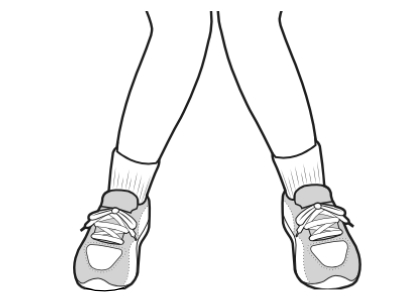Valgus is a descriptive term implying that the lower leg is angled outwards compared to the upper leg, ie a patient may be described as having genu valgum (a knock knee) or a valgus deformity so that the knee appears angled towards the midline.
 Page updated March 2024 by Dr Sheila Strover (Clinical Editor)
Page updated March 2024 by Dr Sheila Strover (Clinical Editor)

Genu valgum is common in childhood. Children are often born with bow-legs, and the limbs gradually straighten but may over-correct into a knock-knee situation. This, too, may correct over time so the child ends up with normal alignment. In some individuals such valgus deformity may persist beyond childhood.
Most cases of valgus deformity in an ordinary orthopaedic practice will relate acquired adult deformities.
What causes valgus knees?
How is valgus measured?
Long leg weight-bearing X-rays are essential for the measurement of the abnormal angulation.
-
Quote from peer-reviewed paper:
....the estimated angle on the X-ray is called the anatomic tibiofemoral angle or femoral-shaft–tibial-shaft angle (FS–TS)....[the] angle is defined by a line drawn from the centre of the proximal femoral shaft towards the knee and a line from the centre of the tibial shaft distal to the knee...."
Citation: Marques Luís N, Varatojo R. Radiological assessment of lower limb alignment. EFORT Open Rev. 2021 Jun 28;6(6):487-494. doi: 10.1302/2058-5241.6.210015. PMID: 34267938; PMCID: PMC8246117.
Should valgus knees always be corrected?
Children are usually evaluated over time and may grow out of the problem.
In an adult correction will depend on the symptoms.
Which osteotomy for a valgus knee?
The long leg X-rays will give an estimate of the degree of correction needed to realign the limb. If the correction needed is large, the surgeon will choose to do an osteotomy in both the femur and the tibia.
-
Quote from peer-reviewed paper:
In valgus deformity of the knee, there are "...five subtypes of bone deformity origins—the supracondylar part of the femur, the distal aspect of the lateral femoral condyle, both distal and posterior aspects of the lateral femoral condyle, the tibial plateau, or the metaphyseal segment of the tibia."
Citation: Yang D, Zhou Y, Shao H, Deng W. Different Deformity Origins and Morphological Features in Subtypes of Valgus Knees: A Radiological Classification System. Orthop Surg. 2022 Jan;14(1):96-103. doi: 10.1111/os.13178. Epub 2021 Dec 6. PMID: 34870368; PMCID: PMC8755874.
Valgus correction during total knee replacement
-
Quote from peer-reviewed paper:
....Valgus knee deformity is a challenge in total knee arthroplasty (TKA) and it is observed in nearly 10 % of patients undergoing TKA....."
Citation: Rossi R, Rosso F, Cottino U, Dettoni F, Bonasia DE, Bruzzone M. Total knee arthroplasty in the valgus knee. Int Orthop. 2014 Feb;38(2):273-83. doi: 10.1007/s00264-013-2227-4. Epub 2013 Dec 24. PMID: 24366186; PMCID: PMC3923939.
Forum discussions
- Knock knees/pain - 22 years old
Patients discuss issues with congenital valgus persisting into adulthood and becoming symptomatic.
 2010 -
2010 -